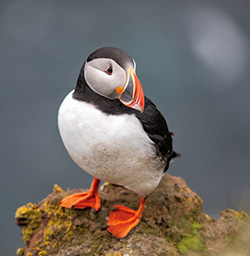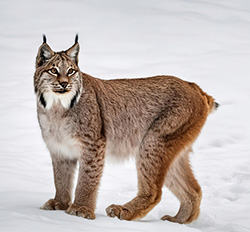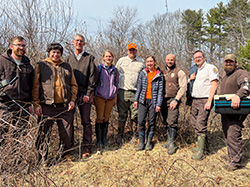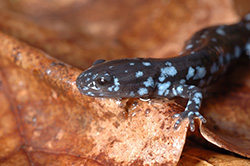Home → Fish & Wildlife → Wildlife → State Wildlife Action Plan
State Wildlife Action Plan

Maine's State Wildlife Action Plan serves as a blueprint and shared vision for proactively conserving the state's fish and wildlife, both keeping common species common and preventing at-risk species from becoming endangered. The plan describes both inland and marine species of greatest conservation need (SGCN) and their habitats, key threats, and recommended conservation actions that can be employed by natural resource agencies, land trusts, towns, and other willing conservation partners. Actions are voluntary, non-regulatory, and are intended to supplement, not duplicate, existing fish and wildlife programs.
MDIFW, conservation partners, and the public developed Maine's previous State Wildlife Action Plans in 2005 and 2015, and are now actively working on a 2025 update. An approved State Wildlife Action Plan is required by the U.S. Fish and Wildlife Service to be eligible for State Wildlife Grants (PDF), a key federal funding source for states to conserve nongame species (plants and animals not legally hunted or fished). The plan is revised every ten years to periodically evaluate the health of wildlife populations and identify opportunities to conserve species and vital habitats before they become rarer and more costly to protect. The plan builds on species planning efforts ongoing in Maine since 1968 and a long history of public involvement and collaboration among conservation partners.
Click below to learn what we have accomplished for Maine's wildlife since 2005 and how you can be involved in the 2025 revision.

2025 Revision of Maine's Wildlife Action Plan
Find out how you can provide input during the revision of the 2025 plan.

2015 Maine Wildlife Action Plan
View Maine's plan to conserve priority wildlife species and habitats throughout the entire state, from the dramatic coastline to the heights of Mt. Katahdin.
Working Together to Develop Maine's Wildlife Action Plan

Maine's Wildlife Action Plan is a shared vision for our state that reflects the expertise and knowledge of over 100 conservation partner groups, including state and federal agencies, tribes, conservation organizations, and other partners - scientists, managers, hunters, anglers, conservationists, landowners, academics, guides, community leaders, and many others - with an interest in working together for Maine's wildlife. This collaboration provides the foundation on which Maine's Wildlife Action Plan was built and will continue to provide input on Plan implementation, tracking, fostering partnerships, building cross-state alliances, and leveraging funding. Given that approximately 94% of Maine is privately owned, landowners are integral to the conservation of our wildlife heritage and natural resources and are an essential component of Maine's Wildlife Action Plan partnership.
Frequently Asked Questions

Maine's 2015-2025 Wildlife Action Plan is a shared vision for our state that identifies the voluntary steps needed to conserve priority wildlife species and habitats through public awareness and partnerships. The Plan identifies Maine's Species of Greatest Conservation Need (SGCN), the habitats where SGCN are found, and the recommended 'conservation actions' to help prevent further declines in species and habitats over the next ten years. The 2015-2025 Plan also qualifies Maine to receive funds for wildlife conservation projects from the U.S. Fish and Wildlife Service (USFWS) under the State Wildlife Grant (SWG) program: http://wsfrprograms.fws.gov/Subpages/GrantPrograms/SWG/SWG.htm
The Maine Department of Inland Fisheries and Wildlife (MDIFW), Maine Department of Marine Resources (DMR), and Maine Natural Areas Program (MNAP) wrote the Plan with input from over 100 'conservation partner' groups representing many interests including private landowners, conservation organizations, sporting groups, scientists, and governmental agencies. The list of invited conservation partners begins on page 15 here: https://www.maine.gov/ifw/docs/swap/2015MaineSWAP_Elements7and8_DRAFT.pdf (PDF)
How was the Species of Greatest Conservation Need (SGCN) list developed?
MDIFW biologists, with review and cooperation from conservation partners and species experts, developed conservation criteria for designating Maine's eligible SGCN. For each species in Maine, MDIFW and partners reviewed the best available science to determine if the SGCN criteria were met. If so, the species was added to the list of SGCN at one of three priority levels (1=critical; 2=high; 3=moderate) depending on which and how many criteria were met. The primary themes for SGCN prioritization include risk of extirpation, population trend, endemicity, and regional conservation concerns. Secondary themes for SGCN prioritization include climate change vulnerability, survey knowledge, and indigenous cultural significance. Information on the SGCN criteria can be found here, beginning on page 25: http://www.maine.gov/docs/swap/2015MaineSWAP_Element1_DRAFT.pdf (PDF).
How are SGCN different from Threatened and Endangered (T/E) Species?
SGCN are different from T/E species in several ways. First, T/E species are eligible for regulation under the Maine and/or Federal Endangered Species Acts (ESA). Some activities that affect these species or habitats also are potentially regulated. In contrast, SGCN species are not regulated. Many state and federal T/E species also qualify for SGCN status; but, this designation does not add any additional regulations. There are many more SGCN than there are listed T/E species. For example, there are 51 T/E species listed under Maine's ESA, but there are 378 SGCN in Maine's 2015-2025 Wildlife Action Plan. By designating a species as SGCN now, we can take preventative steps to avoid the need for listing the species in the future under the State or Federal ESA.
Where can I find the list of SGCN?
The list of SGCN begins on page 31 here: http://www.maine.gov/docs/swap/2015MaineSWAP_Element1_DRAFT.pdf (PDF)
SGCN are organized by groups (e.g., birds, mammals, amphibians, etc.); click on each species to view a report that details how the species qualifies as SGCN, associated habitats, distribution range in Maine, stressors affecting the species and its habitats, and conservation actions proposed to prevent future declines over the next ten years.
What is included in a Wildlife Action Plan?
In order to be approved by USFWS, Wildlife Action Plans must address eight elements (PDF).
Completing the 2015-2025 Plan was just the first step. The success of Maine's 2015-2025 Wildlife Action Plan relies on your participation and partnership. The Plan presents conservation actions ranging from local, SGCN-specific efforts to those with a more regional focus. We hope you will see a role for yourself or your organization in these actions.
If you belong to one of the conservation partner organizations that participated in writing the 2015-2025 Plan (see page 15, http://www.maine.gov/ifw/docs/swap/2015MaineSWAP_Elements7and8_DRAFT.pdf (PDF)), you may wish to contact your local chapter or media representative for more information.
As the Plan is implemented, we hope to provide ongoing workshops and informational sessions on accessing and using Plan information. Please contact us for more information.